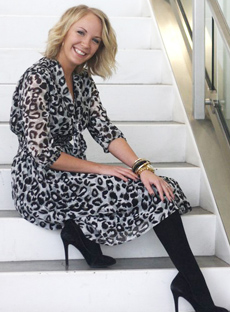But what if you're not trying to sell your home? How dark should you go? I think it depends on a few things:
1. What kind of atmosphere are you trying to create? Light and airy, sleek and moody, or somewhere in between?
2. How much time do you spend in the space? If it's a family room you spend a lot of time in during the day, you may not want to go for a dark saturated ambiance. But a media room where you only watch movies on the weekends? Go as dark as you dare! Because a media room isn't a main living area, you won't grow as tired of the bold color.
3. What time of day do you use the room? A breakfast nook used in the morning should be bright and cheery to welcome the new day, but if that same nook is only used to entertain guests at night, embrace the dark side!
4. How much natural light does the room receive? If a room has large beautiful south-facing windows I wouldn't try to compete with the sun by using dark colors or make it radio active by using bright colors. A soft light color is appropriate here. Recently, though, I was helping a client with a paint color for their basement hallway which had absolutely no natural light. They were brave, took my advise and went with a dark chocolate, much to their neighbor's and painter's chagrin. Now that it is finished, they get tons of compliments on how sharp it looks and they couldn't be happier with our choice (even the painter admitted it looked good!). It worked because we embraced the lack of natural light and it's a transitional space where you don't spend a lot of time. Another example, if you remember, was Katie Ridder's entryway for this year's Kips Bay Showhouse- saturated color with lots of pattern!
Despite popular belief, dark colors don't always make a little room seem tiny. A lot of time dark colors do the opposite by diminishing boundaries, which I tried to explain in yesterday's post. When a room is dark, it makes the objects that are not dark POP so that becomes the focus, not the boundaries. Does that make sense? Here's a few examples of dark rooms that POP:
 |
| Ralph Lauren Brook Street Collection |
 |
| Elle Decor |
 |
| Elle Decor |
A few more tips when it comes to selecting a paint color:
1. Don't be a slave to fashion trends. Most people think they need to paint every wall in their favorite color du jour, but what they don't realize is that the walls are just backdrops to their favorite things. So if you like turquoise, you don't have to paint your room to look like a Tiffany's gift box. Painting your walls a charcoal or chocolate will make your turquoise drapes and lamps POP!
2. Always make a room that looks like the person living in it. Nothing is worse than a room that doesn't feel like "you." Your house will never feel like a home otherwise.
3. I left this one for last because I can't stress it enough. NEVER EVER EVER choose a paint from a chip. EVER! Always buy testers in a variety of colors. An easy way to do this is to take the color you think you want, then get samples in a few shades lighter and darker. Paint LARGE swatches on your wall, live with them for a day or two and come back to them in morning light and evening light before you make your decision. It is well worth the extra $20 in sample paint now then the extra $50-100 in paint plus labor costs for your painter or your personal time if you are a DIYer. Here's a pic of my paint swatches I used in my Master Suite:
I ended up going with the lighter of the two swatches so my espresso stained furniture would contrast, not blend.
So do you agree with me or disagree? Did this help clarify things or did I just confuse you more? I'd love to hear your feedback!
P.S. I thought I'd give you a little encore of my all time favorite dark room, Kelly Wearstler's kitchen:






No comments:
Post a Comment